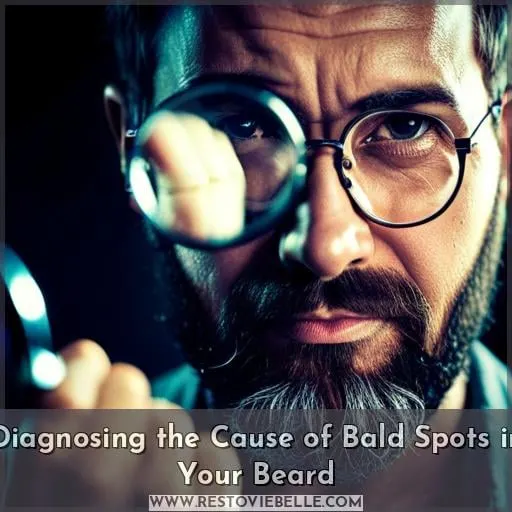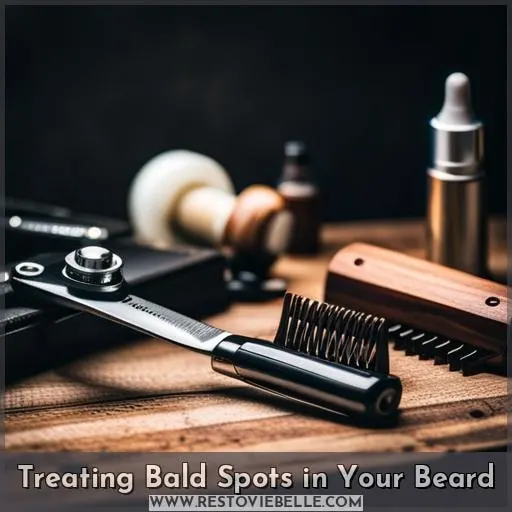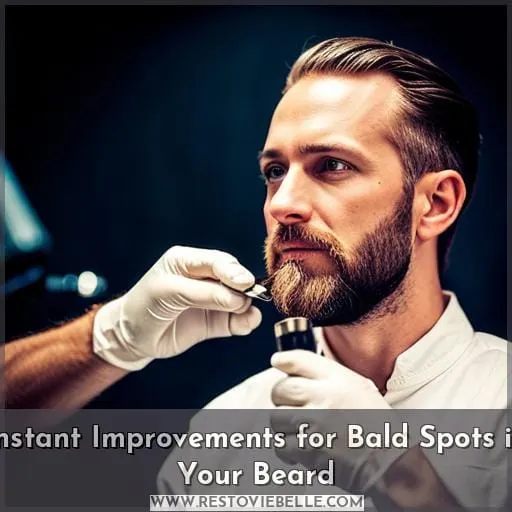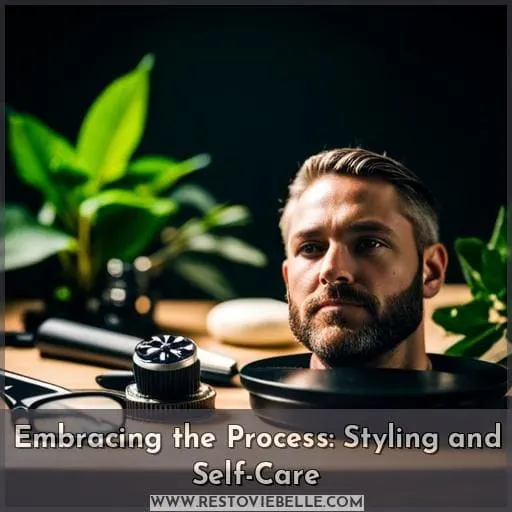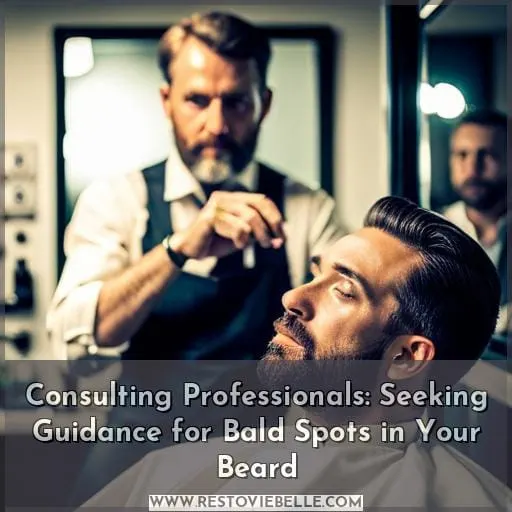This site is supported by our readers. We may earn a commission, at no cost to you, if you purchase through links.
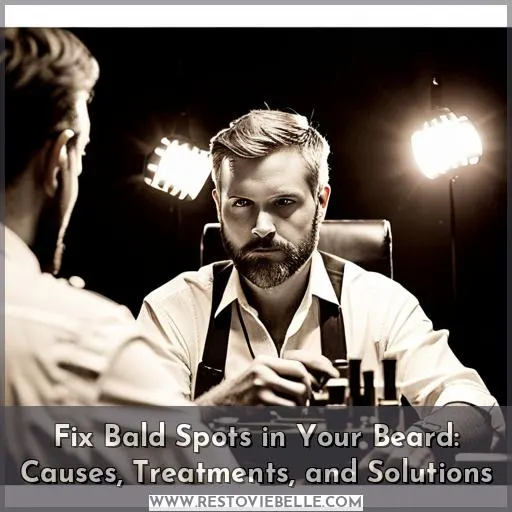 Stepping into something new can be daunting, especially when it comes to overhauling your look. For those of us who want a more rugged appearance but are struggling with bald spots in our beard, the journey to finding a fix can seem like an insurmountable challenge.
Stepping into something new can be daunting, especially when it comes to overhauling your look. For those of us who want a more rugged appearance but are struggling with bald spots in our beard, the journey to finding a fix can seem like an insurmountable challenge.
But fear not! With some patience and perseverance, you’ll soon find yourself on the path towards achieving that glorious manly mane you’ve always dreamed of—or at least, how to fix bald spots in your beard.
From alopecia barbae and male pattern baldness caused by DHT sensitivity levels, through home remedies or lifestyle changes – there are multiple treatment options available for dealing with patchy facial hair growth issues.
We’ll go over all of these causes as well as instant improvements for covering up any existing problems while working towards long-term solutions such as styling tips and medical treatments specifically targeted towards alopecia barbae if needed.
Table Of Contents
- Key Takeaways
- What Causes Bald Spots in Your Beard?
- Diagnosing the Cause of Bald Spots in Your Beard
- Treating Bald Spots in Your Beard
- Instant Improvements for Bald Spots in Your Beard
- Understanding Alopecia Barbae
- Embracing the Process: Styling and Self-Care
- Consulting Professionals: Seeking Guidance for Bald Spots in Your Beard
- Conclusion
Key Takeaways
- Accurate diagnosis is crucial for effective treatment of beard bald spots.
- Treatment options include medical treatments like minoxidil and corticosteroids, as well as cosmetic solutions like hair fibers and micropigmentation.
- Lifestyle factors such as stress reduction, adequate sleep, and DHT blockers can help prevent bald spots.
- Seeking professional advice from dermatologists is essential for personalized and effective treatment plans.
What Causes Bald Spots in Your Beard?
If you have noticed bald spots in your beard, it is important to understand that they could be caused by a variety of factors such as alopecia barbae or other medical conditions and triggers. Researching the underlying cause will help determine appropriate treatments for achieving the desired results.
Alopecia Barbae
If you’re noticing patches of missing hair on your face, it could be a sign of alopecia barbae, an autoimmune condition that affects the hair follicles. It’s associated with other autoimmune conditions and can result from medical treatments like chemotherapy or fungal infections such as ringworm.
Diagnosis is made through examination and tests to differentiate between sudden vs patchy growth caused by hormonal imbalances or immune-related issues. Treatments range from topical solutions such as minoxidil, PRP therapy, and laser light to supportive therapies like natural supplements and Vitamin E for emotional impact.
Other Causes
Apart from alopecia barbae, other factors can contribute to patchy beard growth, such as medications, fungal infections, and even lack of sleep.
Alternative treatments like minoxidil, topical steroids, or laser therapy may help regrow lost patches. Incorporating a good beard care routine will also promote natural hair growth. Additionally, dietary considerations, such as adding vitamin E supplements into your diet, provide essential nutrients for healthier follicles.
It is important to note that emotional well-being plays a significant role in bald spots due to stress triggers. If necessary, attending counseling sessions can lead to better mental health outcomes.
Consult your dermatologist today to personalize the best treatment plan tailored specifically for you.
Diagnosing the Cause of Bald Spots in Your Beard
Uncovering the root cause of any patchy spots in your beard can help you determine the best course of action. Common triggers include hormonal imbalances, autoimmune disorders, and medications like chemotherapy.
A dermatologist’s role is to accurately distinguish between these hair loss causes and provide a tailored treatment plan for each patient.
Hormonal issues may be due to lower testosterone or DHT levels, which impact natural growth and require targeted interventions such as minoxidil treatments or laser light therapy solutions. Autoimmune conditions like alopecia barbae are often linked to other underlying medical issues but can also be triggered by environmental factors such as stress or sleep deprivation.
These factors negatively affect our immune system’s response, causing bald patches on face areas including the neck and chin area.
With an accurate diagnosis, it is possible to treat both types effectively using topical solutions like minoxidil creams, PRP injections, or Rosemary oil applications (not for facial use). In more severe cases, permanent approaches like transplant surgeries may be necessary.
Treating Bald Spots in Your Beard
If you are struggling with bald spots in your beard, there are several treatments available. Lasting solutions such as a beard transplant can be effective for patchy growth, while alopecia barbae treatments involve medications and supplements like corticosteroids or vitamin E supplements.
Other causes of hair loss may require different approaches such as removal of triggers (e.
Lasting Solutions
For lasting solutions to your beard bald spots, consider a professional consultation and treatments like beard transplantation. You could also opt for PRP therapy, laser treatment, or topical solutions that stimulate regrowth naturally.
Natural remedies can also help minimize the loss of hair. Home remedies will provide temporary improvement in appearance with products such as thickening spray or hair fibers. Consider natural solutions such as rosemary oil, which blocks DHT, and Vitamin E supplements for alopecia areata to further support healthy growth without resorting to medical procedures.
Finally, always apply proper grooming techniques with care products like a brush and wash.
Alopecia Barbae Treatments
If you’re experiencing patchy, round bald spots in your beard, it may be alopecia barbae and may require specialized treatments. A dermatologist can recommend supportive therapies, such as corticosteroids, to help reduce the immune system attack.
Natural supplements, like Vitamin E and zinc, have also been found helpful for hair growth. There’s an emotional impact of this condition that should not be overlooked. Consider seeking therapy or joining a support group for guidance and understanding.
Adjusting your lifestyle with a balanced diet, improved sleep habits, and avoiding triggers is crucial too! Dermatologist recommendations are key when managing alopecia barbae treatments. However, there are some natural remedies available if genetics put you at a higher risk of beard hair loss from this condition.
Other Causes’ Treatments
Treating the underlying triggers of your beard bald spots can help you regain confidence and give back a sense of control. Home remedies like garlic gel, Viviscal supplement, zinc, and biotin may be beneficial.
Lifestyle changes, such as reducing stress or getting enough sleep, are important preventive measures against hair loss. Dietary supplements rich in DHT blockers may also prove helpful for some cases. It is always advisable to consider natural solutions and seek professional advice from a specialized hair loss specialist when dealing with an autoimmune condition like alopecia barbae, which causes patchy growth on the face and neck area.
Instant Improvements for Bald Spots in Your Beard
If you’re looking for quick fixes for bald spots in your beard, there are a few cosmetic solutions and home remedies that can help. From hair fibers and thickening spray to Vitamin E supplements and balanced diets, these treatments provide instant improvements while addressing the underlying causes of baldness.
Cosmetic Solutions
Surprisingly, cosmetic solutions can offer quick and easy improvements to your beard’s appearance. From hair fiber products that stick directly onto the skin and fill in bald spots to micropigmentation techniques like beard tattoos or makeup concealers, there are a variety of options available for those looking for an instant boost.
For more permanent regrowth treatments such as PRP therapy and low-level laser light treatment, consult with a doctor or dermatologist first. Incorporating these into your grooming routine might help you feel confident about yourself while waiting on other potential hair regrowth treatments.
The right combination of proper care products like oil balm wash brush, along with the use of natural ingredients, is also important when dealing with bald spots in beards!
Home Remedies and Lifestyle Factors
To stimulate beard growth, incorporate home remedies like garlic gel and Viviscal supplements into your routine, while also prioritizing a balanced diet and sufficient sleep. Essential oils, such as rosemary oil, can help inhibit DHT production. Hair fibers are perfect for instantly filling in gaps, while styling tips can help you make the most of what you have.
For emotional well-being, self-care strategies play an important role – therapy or support groups may be beneficial if needed.
Understanding Alopecia Barbae
Alopecia barbae is a form of alopecia areata, an autoimmune condition that targets hair follicles on the neck and face. It is characterized by sudden bald spots in circular patches, accompanied by itching or pain in the affected area; exclamation mark hairs; redness and inflammation.
Medical treatments include corticosteroids (topical or injections), minoxidil (Rogaine), DPCP, and anthralin, while home remedies like garlic gel, Viviscal supplements, and zinc can also be helpful. To cope with its emotional impact, it is important to seek support from therapy or groups and prioritize self-care for overall well-being.
Specifics of Alopecia Barbae
Alopecia barbae can be a difficult condition to recognize, with its sudden patches of circular baldness and tell-tale exclamation mark hairs. Causes and triggers include an autoimmune disease targeting hair follicles, medications like chemotherapy, fungal infections, and hormones.
Treatment approaches range from topical solutions such as minoxidil or low-level laser light therapy to more lasting options like beard transplants. The diagnostic process involves examining the skin for clues while considering any rash present, plus new medications taken or sleep issues experienced.
Support options are available through vitamin E supplements for alopecia areata treatment, plus emotional impact management via therapy or support groups.
Diagnosis and Symptoms
Diagnosing alopecia barbae starts with recognizing symptoms such as circular bald patches, exclamation mark hairs, and itchy or painful skin. Redness and inflammation may also be present. To confirm the diagnosis, a doctor/dermatologist might recommend a scalp biopsy or blood tests to rule out other medical conditions causing patchy beard growth.
Once diagnosed, treatments can include topical corticosteroids for mild cases; minoxidil (Rogaine) for moderate-to-severe cases; DPCP immunotherapy injections if medications don’t work; anthralin cream if severe hair loss is observed in areas other than the face/beard area.
Medical Treatments
If you’re looking for relief from your patchy beard, medical treatments like corticosteroids, minoxidil, and DPCP may be just what you need. Your dermatologist can recommend the best solution for your individual situation.
Corticosteroids involve topical or injected medication to reduce inflammation of hair follicles.
Minoxidil is a topical application that promotes blood flow to the scalp and stimulates facial hair growth in men with alopecia areata.
Lastly, Dermatophagoides pteronyssinus (DPCP) therapy uses diluted allergens placed on areas of thinning hair. This treatment can result in thicker-looking locks over time with consistent applications.
Natural remedies such as garlic gel or zinc supplements may also help restore lost hairs but should not replace professional medical advice when considering treatment options for Alopecia Barbae bald spots!
Home Remedies and Support
You can also look into home remedies and support to help manage alopecia barbae. An ounce of prevention is worth a pound of cure. Natural remedies like garlic gel, Viviscal supplements, zinc, and biotin may reduce symptoms.
To address the emotional impact that alopecia barbae has on self-esteem, consider joining a support group or seeking therapy from mental health professionals. Additionally, use beard before and after photos for reassurance. Also, change up hair texture through styling techniques based on skin type to improve natural growth over time.
Even though it’s not an instant fix, be sure to practice self-care as you work towards regrowth!
Embracing the Process: Styling and Self-Care
If you’re dealing with bald spots in your beard, there are a few key tips to consider for styling and self-care. To ensure optimal growth of hair and confidence within yourself, it’s important to avoid over-trimming the beard, select styles that suit your face shape, and embrace your look while working on its growth.
Additionally, use proper beard care products like oil, balm, wash, or brush to stimulate new healthy hair follicles.
Styling Tips
When styling your beard, it’s important to choose a style that suits the shape of your face and avoid overtrimming. Face framing styles like goatees or soul patches can help balance facial symmetry while helping reduce stress.
Eating a healthy diet and using proper grooming techniques also contribute to filling in patchy beards.
Remember that alopecia barbae carries an emotional impact, so take time for self-care too.
Self-Care and Confidence
Embrace your unique look while taking steps to improve the health of your beard and confidence in yourself. Incorporate beard grooming techniques and boost self-esteem with confidence-building activities.
Establish a self-care routine for personal growth. Attend support groups or talk therapy to cope with hair loss and emotional well-being.
Find ways to be kinder to yourself. Use positive affirmations, take up new hobbies that bring joy, and explore nature’s beauty. All of these will aid in boosting positivity around you. Finally, remember that it takes time, but eventually, you’ll have control over how you approach alopecia barbae.
Consulting Professionals: Seeking Guidance for Bald Spots in Your Beard
If you’re experiencing patchy beard growth, seeking professional help from a doctor or dermatologist can provide guidance on the best treatments for your individual needs. A clinical assessment by an expert can identify underlying causes and determine the most suitable treatment options.
The table below outlines some of these potential solutions:
| Treatment Option | Description | Benefit |
|---|---|---|
| Dermatologist Consultation | Evaluation and diagnosis of bald spots | Expert advice tailored to specific condition |
| Voluminous beard with proper care | ||
| DPCP allergic reaction prevention | ||
| Anthralin cream usage instructions | ||
| Zinc & Biotin supplementation recommendations | ||
| Online support resources |
Professional Diagnosis, Clinical Assessment, Treatment Options, Expert Advice
Conclusion
According to a report, the global beard grooming market is set to grow 40% by 2026, making it a booming industry for men looking to perfect their beards. With many men relying on their beards to boost confidence and attractiveness, bald spots can be a source of distress.
Fortunately, there are effective treatments available for patchy beards due to alopecia barbae, as well as a variety of other causes. From medical treatments to home remedies and styling tips, there are plenty of solutions to fix bald spots in your beard.
But before you take matters into your own hands, it’s important to consult a professional for an accurate diagnosis and tailored treatment plan. With the right care and attention, you can get your beard back to looking and feeling its best in no time.

